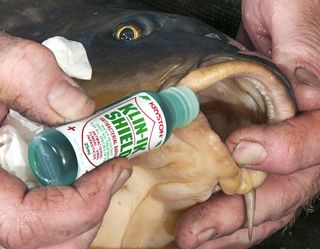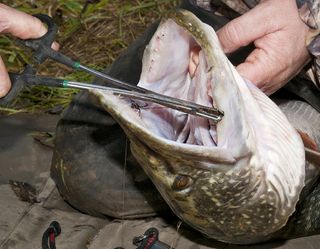Fish care: how to look after your catch
When it comes to fish care, carp get all the attention, some fisheries now insisting that carp anglers carry and use proprietary fish care products on all hook-holds and any evident skin or scale damage. It begs the question: why not for other species? Fishery scientist Ian Welch explains the correct procedure for all types of fish.

Fish care should be a top priority for all anglers. Fish live in a non-sterile environment, and are constantly surrounded by potentially harmful pathogens, such as fungi, bacteria and viruses, all of which look to exploit any biological weakness. The mucus layer acts as a physical barrier to any infectious organisms in a healthy, uninjured fish, and can prevent secondary infections on areas of minor physical damage. If the nature of an injury is such that the mucus is not effective, then the wound is open to secondary infection.
The immune system is the first line of defence after injury, with white blood cells, called leucocytes, flooding the damaged area and helping prevent infection by neutralising foreign bacteria. Some release histamines to control inflammation, others ‘killer cells’ that seek and destroy bacteria and fungi, and further variants release antibodies to attach to and control disease organisms. It is a highly specialised and highly evolved response mechanism that is incredibly effective.
Angler intervention in the care process is rarely required, and it may be counterproductive. It could however provide some benefit in waters where fish are stressed, possibly relating to overstocking or poor water quality, and have a compromised immune system as a result.

Wound treatment procedure
To be fully effective, a wound should first be treated with an antiseptic, to kill any pathogens present and to help prevent future infection. It should then be sealed with an impermeable barrier, to ensure that the contact of the antiseptic with the damaged area remains for a reasonable time, and act as a physical barrier, in much the same way that a natural layer of mucus does.
1 Dry the wound
Drying a wound will ensure that the medication adheres, and is easily achieved with a paper towel. Ensure that only the area of damage and its immediate surround is dried, do not remove mucus from surrounding areas.
2 Apply antiseptic directly to the wound itself
Advnture Newsletter
All the latest inspiration, tips and guides to help you plan your next Advnture!
Antiseptic should be applied directly to the wound only, ensuring that you avoid eye and gill areas, and a clean, dry cotton bud is ideal. I carry a small bottle of iodine, which is available from any chemist, and swab the area of damage, working it gently into the tissue. A commercial carp care product should also do the job.
3 Apply a barrier treatment
To maintain contact between the wound and the antiseptic, you’ll need to create a physical barrier. I have always favoured mouth ulcer gels, as they are designed to adhere to wet surfaces and contain anti-inflammatories, but some commercial carp care products now contain a waxy barrier. Alternatively, a smear of Vaseline will suffice.

Unhooking pike
In respect of pike, I would strongly advise against the treatment of hook-holds. Many of these will be in bony tissue and among the rows of strong, sharp teeth where damage to the fish is unlikely to result. Fish hooked in the softer tissue at the back of the mouth or deeply hooked should be treated as outlined in the excellent online guide provided by the Pike Anglers’ Club at pacgb.com Any injuries to the body of the fish may be treated in exactly the same way as for carp, as highlighted in the procedure below.

Key fish care pointers
Always follow fishery rules, but the best thing you can do for any fish is to learn and apply proper unhooking and handling techniques. Injuries and certainly minor hook-hold marks are usually best healed by the fish themselves. They’ve been doing a pretty good job of it for a very long time.
1 Keeping calm and collected helps the unhooking procedure run smoothly.
2 The last thing you want is a lively fish flapping around on the mat while you’re frantically searching for forceps, slings and scales buried somewhere among your kit. Minimise the time that your fish is out of the water by having everything close to hand.
3 Always ensure that your unhooking mat is under the fish when taking trophy pictures, and keep it low to the ground at all times.
4 Never stand up with a fish when posing for photos.
5 Damage to the delicate gill rakes of a fish can cause fatal haemorrhaging.
6 Take care when removing hooks. Jabbing away with a disgorger isn’t going to do the fish any favours, and the clumsy use of forceps near fragile gills is a recipe for disaster.
7 Dousing an unhooking mat with lake water helps to minimise the loss of the protective layer of mucus found on fish.
8 Unhooking and releasing a fish from a net is by far the safest method.
9 Don’t release the fish straight away. Give it time to make a full recovery while holding it in the water, only releasing it when it is strong enough to swim off.
Running from 1964 until 2020, Angler's Mail was the UK's leading weekly magazine devoted to coarse fishing, telling readers everything they needed to know about which fish to catch, where to catch them, and what kit they needed to do it. Now, loads of the magazine's expert advice can be found on Advnture.com, as a helpful resource for angling newcomers and experts alike.
Most Popular

